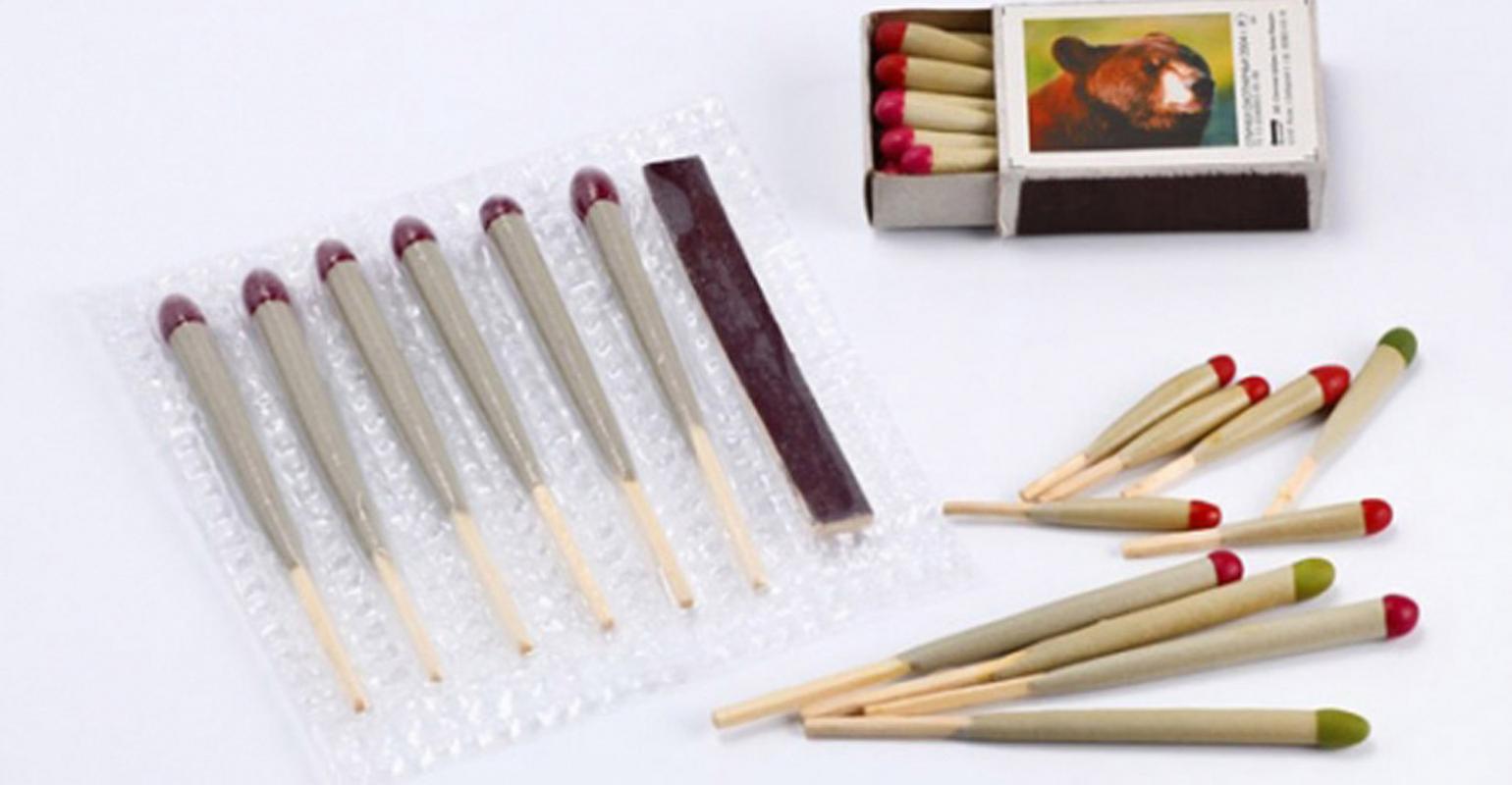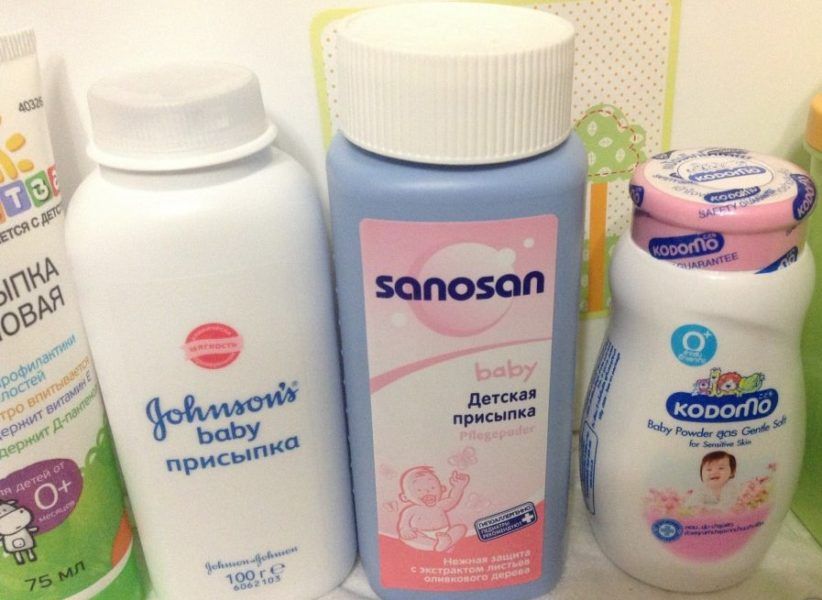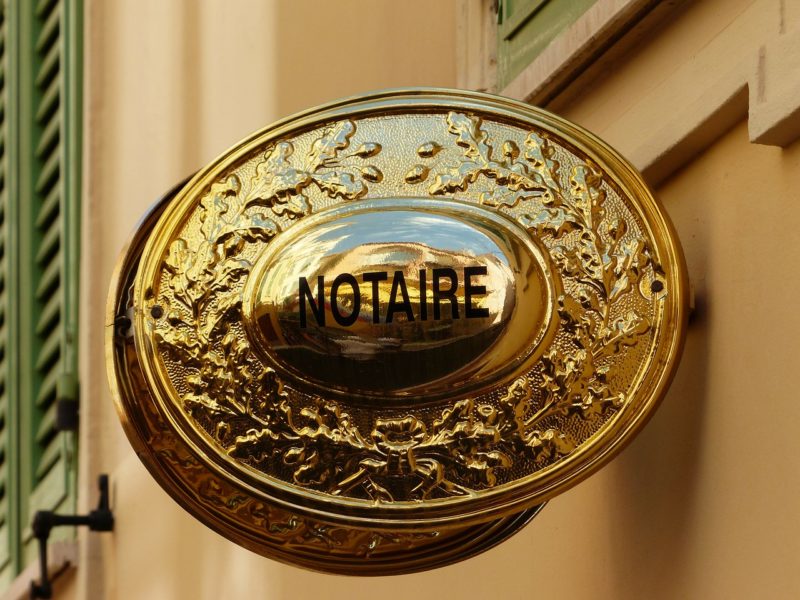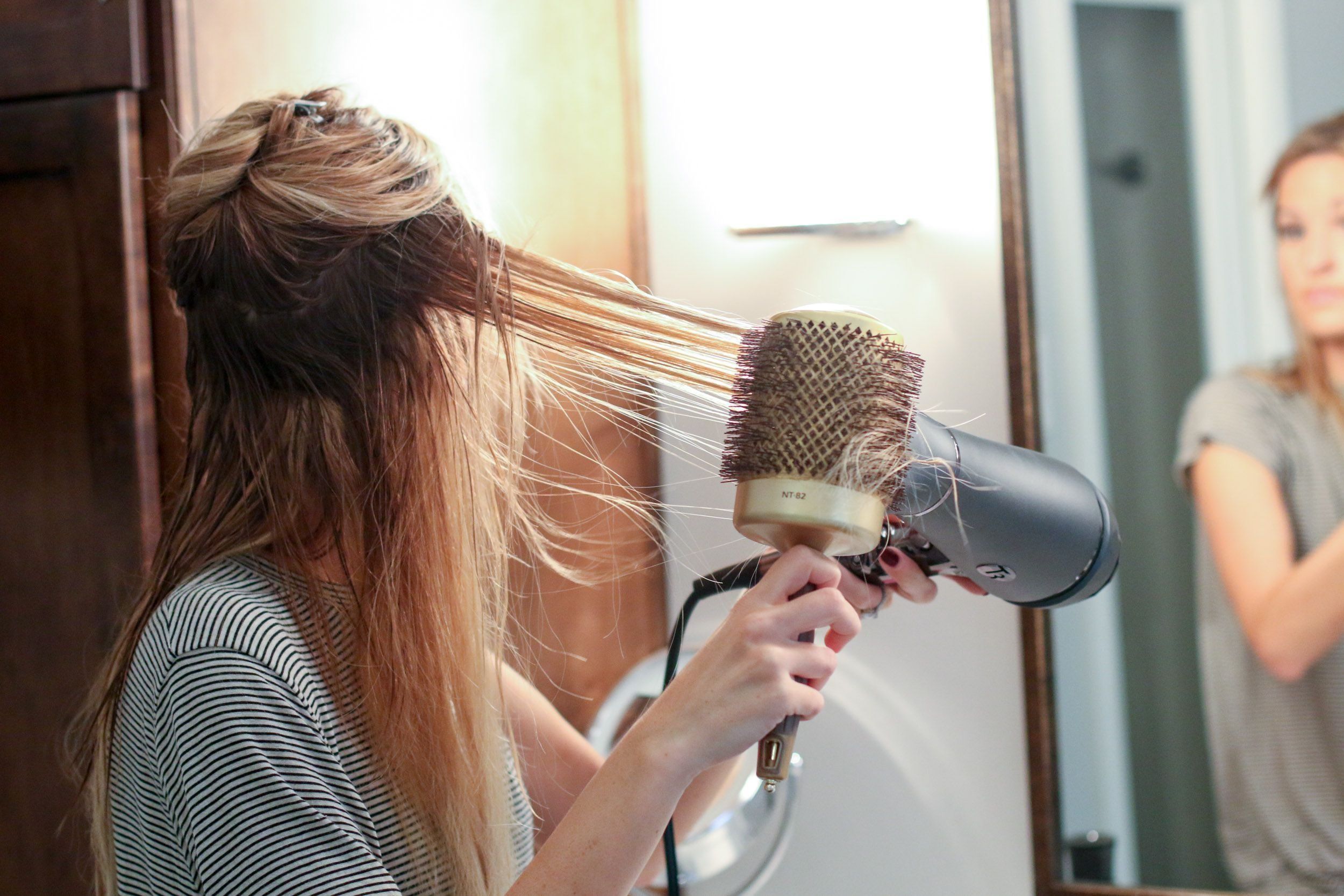Rating of the best plasters for 2025

Today it is difficult to imagine a quality repair without plastering the walls. In principle, you can do without plaster. If we are talking about repairs in a panel house, it is quite possible to use putty there (but even then not in any case), but if we talk about brick houses, then in them without a powerful plaster layer, a quality repair simply will not work. Modern types of plaster are designed to carry not only a finishing, but also a decorative function. Thus, to create a beautiful and reliable home, you need to correctly select the appropriate plaster for repairs.
Content [Hide]
- 1 The main purpose of plaster
- 2 Differences in plaster mixtures by the base used
- 3 Plaster selection options
- 4 Pros and cons of dry and wet plaster
- 5 Competent choice of decorative plaster
- 6 Rating of the best plasters for 2025
- 7 Instead of an epilogue
The main purpose of plaster
Its main purpose is known to everyone who has ever encountered the problem of correcting irregularities on the walls. House builders are not always able to do the job in good faith, so in domestic buildings there are often walls with pronounced irregularities and roughness, and which may even deviate from the norm in terms of level. Here, to eliminate all these problems, plaster mixtures are used.
Currently, the modern market is able to offer a huge range of plaster, ranging from construction to decorative. There are three main types in total:
- Standard mixtures - they are used everywhere, by means of trimming surfaces and similar products require final processing with other materials.
- Special mixtures - they have additional properties. For example, there are samples that are capable of providing increased sound and heat insulating properties.
- Mixtures are decorative - in some cases they do not even require finishing.With their help, a beautiful surface texture, exclusive reliefs are formed, which can also be painted according to the design idea.
Differences in plaster mixtures by the base used
As part of the plaster of any kind there is a binding base, which attaches the entire mass to the walls, and it is also designed to ensure reliable contact with the bearing surface after drying is completed.
Cement plasters – they are the most popular on the market and combine operational durability, ease of use and cheap price. They can be used for both interior and exterior decoration. This solution, in principle, can be made independently if Portland cement is available. It only needs to be diluted with sand of various fineness, which will act as a filler. The advantages of these solutions are called high resistance to adverse weather events, they perfectly tolerate both summer heat and winter frost. Their disadvantages are the occurrence of cracks that form after drying (you will have to close them up with putty). Among other things, cement-based mixtures cling weakly to concrete bases, so when plastering walls in a panel house with such mixtures, you will need to tinker pretty much or choose a different composition. An additional disadvantage will be that, as a result of their excessive mass, they can shrink and practically “slide” along the wall. Finishing cement plaster is best done with a primer.
Gypsum compositions - in them, gypsum acts as a binding base, which, upon contact with water, becomes viscous and has greater adhesion to the surface than cement.Gypsum fractions are somewhat smaller compared to cement, so this solution can even serve as a putty. After applying such a composition and drying it, the surface becomes very smooth and does not even require finishing sanding. It is possible to immediately stick wallpaper or apply paint on such a surface, however, it is better to play it safe and prime it. Gypsum dries extremely quickly (about twice as fast as cement), which significantly saves repair time. The disadvantages of plaster based on gypsum include its poor resistance to moisture. It is simply not recommended to use these solutions in bathrooms and bathrooms, as well as an external finishing material. However, for indoor living spaces, this will be an excellent option. Nevertheless, gypsum is also poorly resistant to mechanical stress and is afraid of strong blows or cuts.
Lime mortars - they differ in the complexity of application, but, in turn, are considered extremely environmentally friendly. They are used for finishing various types of surfaces (and even wood). Such mixtures have excellent antibacterial properties, which makes them indispensable for finishing rooms with high humidity.
Acrylic plaster used as a decorative option. It lays down quickly and dries quickly. However, it is extremely sensitive to ultraviolet rays, therefore it is necessary to avoid permanent exposure of the treated surface to direct sunlight.
Silicate compounds - they are prepared on the basis of liquid glass. Perfectly pass gaseous substances, including steam. After drying, they do not form cracks at all, they mainly play a decorative role.
Silicone plasters – perfectly adhere to different surfaces, providing the maximum level of adhesion. Resistant to aggressive environments and substances with acid-base properties. They also play the role of a decorative finishing material.
Mineral solutions - are intended for better adhesion to the materials that will be used for final finishing. Its structure includes small chips, which helps different materials better adhere to the surface.

Plaster selection options
Each composition has its own texture. First of all, this applies to decorative plasters. So, on the basis of cement plaster, you can perform original decoration in the styles of "bark beetle" or "fur coat", and after painting them (the walls) will generally look like an exclusive design idea. Thus, if the goal is not to complete the original finish, then there is no need to spend money on expensive compositions.
In addition, you should pay attention to the mass of the composition and, before applying it, once again make sure that the walls can withstand it. If it is planned to process a thick layer of walls from thin-block ASGs, then it is necessary to select a lighter solution.
At the same time, you should pay attention to the type of surface where the plaster will be laid. An incorrectly selected composition will not achieve proper adhesion, and after drying, the entire wall may even collapse. Therefore, when buying a mixture, you should familiarize yourself with the manufacturer's recommendations and with what type of surface he advises to treat with this composition.
Before plastering, you need to make all the necessary measurements of wall deviations using plumb lines and levels. You also need to calculate the required volume of the solution in advance, but it is better to take it with a margin.
Features of the choice of plaster for the bathroom
Plastering bathrooms will depend on the material from which the walls are made. The main condition that will be presented to the mixture is that it must have water-repellent properties, because there will be constant contact of the walls with moisture in the room. An excellent option for finishing such premises is tile. In a relatively dry bathroom or in a well-ventilated shower room, a water-repellent gypsum mix can be used for finishing. Nevertheless, despite the fact that it repels moisture well, it is still prone to destruction over time.
In this case, the cement base will become a more versatile tool and the best option for finishing the described premises. It can be produced in various modifications, depending on the wall material:
- For concrete - professionals recommend choosing a cement-lime mortar or the latest polymer-cement plaster with additives and plasticizers for such surfaces, which give the mortar greater plasticity;
- For brick walls - they are rather inert with respect to moisture, which is why it is possible to use any of the following compositions for them: lime, cement, cement-sand;
- For aerated concrete - this material is characterized by increased porosity and has a corrugated surface. Walls made of this material require mandatory alignment. For these purposes, special mortars with reinforcing additions are well suited, and cement samples simply cannot cope with them.
To process the ceiling and the water pipes located near it, you will need a silicone-based plaster for wet rooms with special inclusions. Such a building substance is called sanitizing and is characterized by high performance properties.
Features of the selection of plaster for leveling walls
Ideally smooth walls can be achieved not only with the help of drywall, but also with the help of special plaster solutions. The choice of funds will depend on personal preferences and be determined by the material from which the walls are made. For leveling large areas, it is preferable to use a lime or cement base. To level walls with small cracks and potholes, the following types of plaster can be used:
- Silicone-based - it consists of mineral inclusions, pigments and silicone resins and can be used in any room;
- Acrylic-based - it includes acrylic resins and also mineral components, however, this composition has increased combustible properties, and therefore it is better not to use it in rooms with high temperatures (steam rooms, kitchen workshops, etc.);
- On a silicate basis - the mixture is distinguished by its versatility, it also has a mineral filler, pigments and liquid glass in its structure - all these components provide a high-quality coating;
- On a mineral basis - the most budget option, which does not have special advantages, as well as contraindications.
Before pasting the walls with wallpaper, they must be leveled to hide cracks and depressions, fill the seams between the masonry, etc. Otherwise, due to an uneven surface, the wallpaper may overlap or, conversely, a gap may form between the joints of the two canvases. Among other things, plastering the walls will give them additional thermal insulation properties and will not let cold air into the room, and warm air will not let it out.
Often, plaster can be confused with putty.They, of course, are a bit similar in their properties, but there is also a significant difference - the plaster mixture is used to treat surfaces with a high level of curvature and it has more properties of facade plaster, because there is a filler in its structure. Putty, on the contrary, has a smoother structure and is applied over the plastered surface in order to smooth out the graininess of the latter.
At the same time, there is no single answer to the question of the best plaster for apartment walls. In each particular case, everything will depend on many parameters: wall material (brick or concrete), expected operating conditions (high humidity, standard temperature conditions) and many others. In any case, in order to achieve the highest quality result, no one forbids combining different types of mixtures.
Pros and cons of dry and wet plaster
To make a decision on the use of a particular type of mixture for finishing (dry or wet), it is necessary to determine the properties of the coating to be processed. Dry plaster is often referred to as drywall, and wet is the alignment of walls with a liquid solution. When using the former, the thickness of the coating must always be adjusted, which is in direct proportion to the level of surface roughness. Each designated type has its positive and negative sides.
The structure of drywall includes three layers: cardboard itself, a gypsum layer and cardboard again. It can be used not only for trimming wall surfaces, but also for arranging suspended ceilings, as well as window and door slopes and various partitions. Its merits are as follows:
- Easy installation;
- Good strength;
- The presence of universal qualities;
- Ecological composition.
Its disadvantages include the possible occurrence of cracking, the lack of resistance to hot steam and moisture, the difficulty of attaching various accessories to its surface.
Wet plaster is often called monolithic, which is due to the fact that upon completion of drying, it leaves a perfectly flat surface (without joints). Such processing takes much more time than laying drywall sheets. The master must manually apply the finished mixture to the wall surface and properly level it before it dries. The advantages of wet plaster include:
- Saves space without "eating" it. It is fixed block by block with a special thickness, which is quite easy to adjust.
- Possesses the increased durability (average operational term from 15 to 30 years). And if you carry out proper care, then even more.
- Resistant to mechanical stress, which cannot be said about drywall, with careless handling of which dents easily occur;
- Resistant to moisture - it is simply not afraid of steam and water, which is why it can be used in the kitchen and bathroom.
Competent choice of decorative plaster
Decorative plastering is used as a finishing wall covering. A wide range of textures and colors allows you to choose a specific plaster type for the desired interior. According to the basic connecting element, again, it can be divided into:
- silicate;
- acrylic;
- silicone;
- Mineral.
mineral solutions are prepared on the basis of cement, and special mineral elements, marble chips, etc. are added to their composition. It is produced as a standard in the form of a dry powder, which must be diluted with water before work.This coating has a high degree of adhesion to the surface, and it can easily be given the color and texture of any material (wood, drywall, plywood, etc.). The advantages of such a coating can be called excellent resistance to mechanical damage, environmental safety, fire resistance and increased strength.
into the structure silicone mixtures are mixed with resin, which makes the structure of the material more original (“bark beetle”, “lamb” style). Due to its elasticity, it is very convenient to work with such a mass. It passes steam well, is resistant to moisture, has UV protection, can be self-cleaned and does not collect excess dust. Even if dirt gets on the coating, it can be easily removed with a damp sponge.
Acrylic solutions are made on the basis of acrylic resin. They resist temperature changes well, are not subject to cracking, and are sold immediately ready-made. But it is strictly not recommended to cover walls that are insulated with mineral wool with this solution.
AT silicate liquid glass is added to the mixture, so the mixture becomes elastic and durable and does not crack over time. And taking care of it is as easy as shelling pears: to clean the dust, you can simply wash the wall with any detergent. The mixture itself dries quickly, so professional skills will be required to apply it to the walls.
Rating of the best plasters for 2025
Cement
2nd place: PLITONIT Т1+
votes 1
The structure of this sample contains reinforcing fibers and water-repellent elements. Equally well suited for both exterior and interior decoration. Excellent performance is observed on various surfaces: brick, concrete, aerated concrete. Does not form cracks after drying.
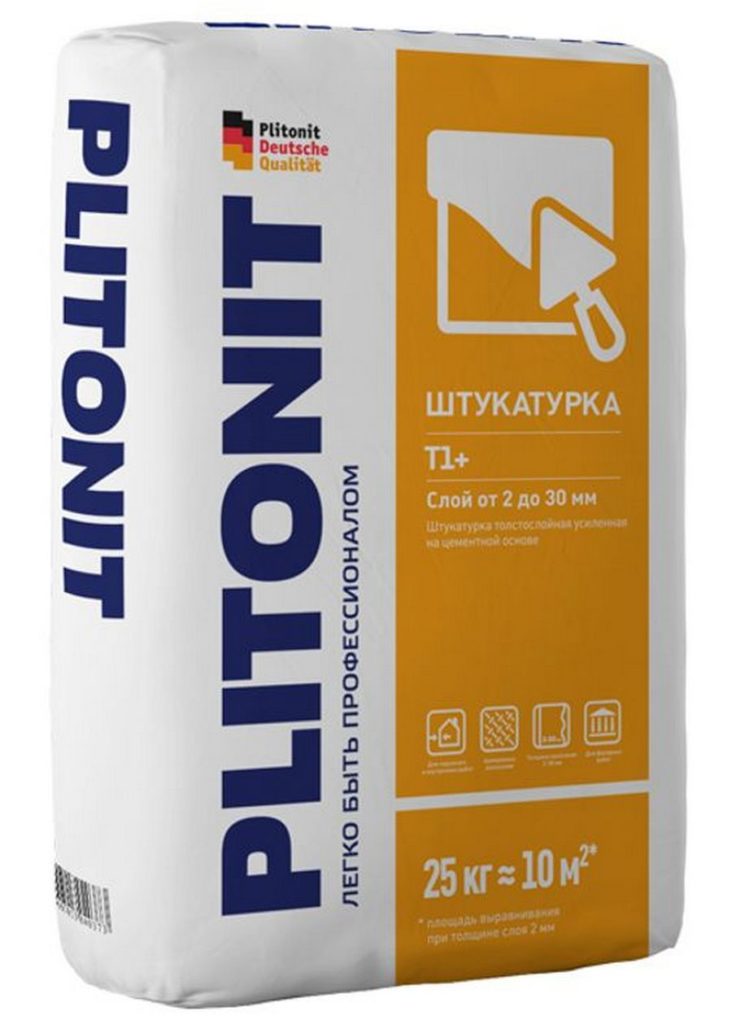
| Name | Index |
|---|---|
| Packing, kg | 25 |
| Manufacturer | Germany |
| Price, rubles | 290 |
- Economic consumption of the total mass;
- Large range of thickness;
- Acceptable moisture resistance.
- Hand application preferred.
1st place: Kreps Master
votes 0
A good example from a local manufacturer. It is produced in the form of a composition of fine sand, plasticizers and cement. It is characterized by a fairly economical consumption of material. After application, it shows excellent adhesion in both dry and wet areas. Both manual and mechanized application is possible.
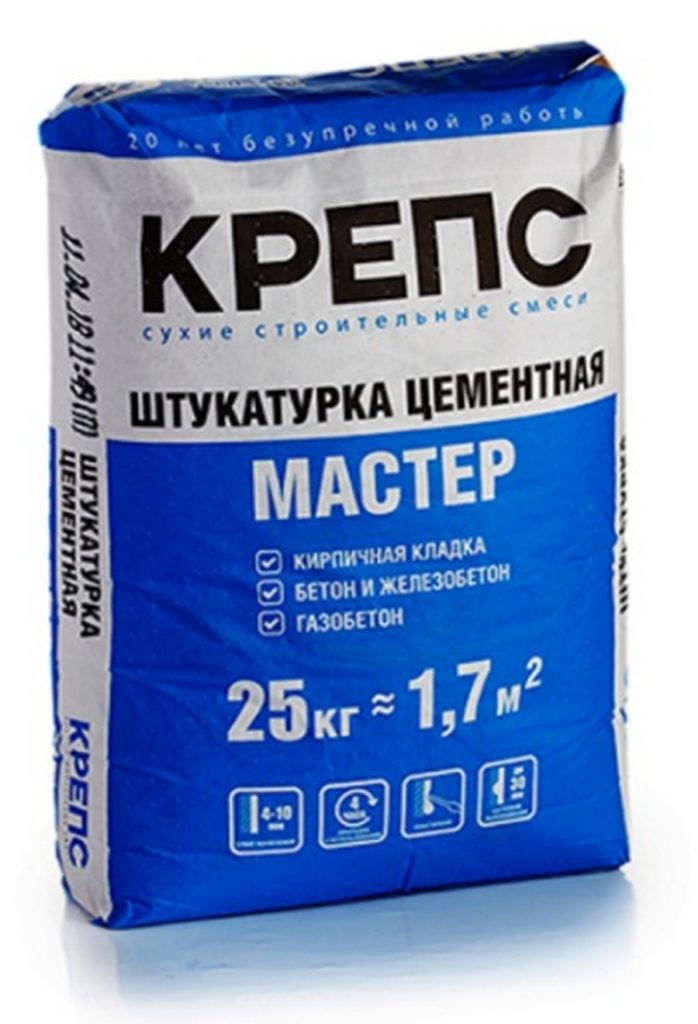
| Name | Index |
|---|---|
| Packing, kg | 25 |
| Manufacturer | Russia |
| Price, rubles | 350 |
- hardened layer;
- Good adhesion to the surface;
- Easy to apply.
- Dries quickly - hard to fix.
Gypsum
2nd place: VOLMA Layer
votes 0
The base of this composition uses a very high-quality type of gypsum, to which chemical and mineral inclusions are added. Its main advantage is the resulting glossy surface of the applied layer. It can be used not only on standard substrates (concrete and brick), but also perfectly adheres to plasterboard surfaces. Usually, even finishing with putty is not required.
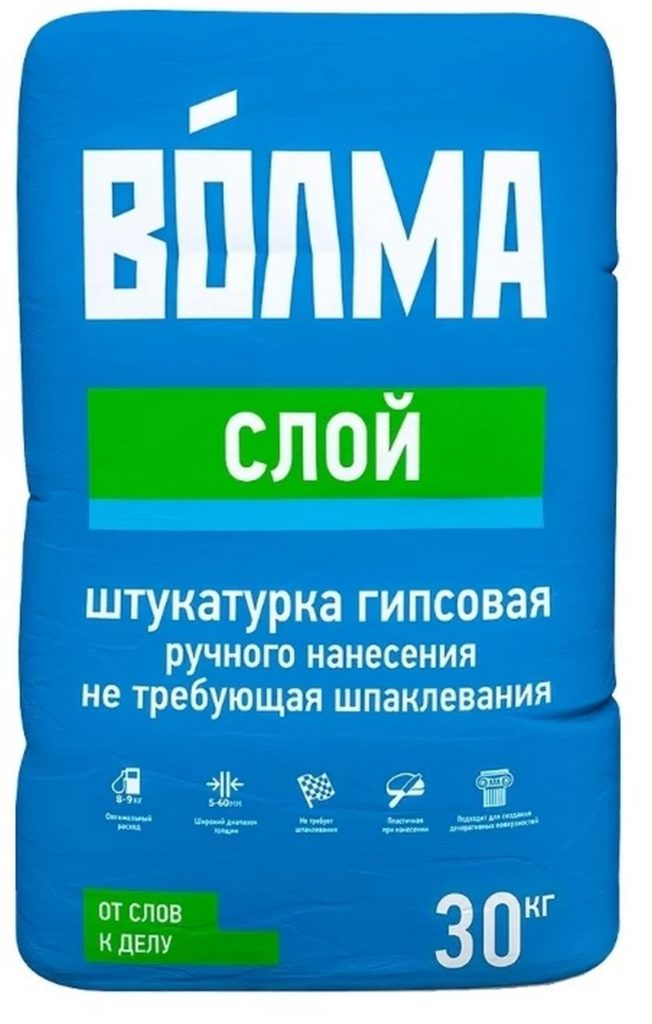
| Name | Index |
|---|---|
| Packing, kg | 30 |
| Manufacturer | Russia |
| Price, rubles | 385 |
- Environmental friendliness;
- Excellent adhesion;
- Pure composition.
- Loss of elasticity half an hour after kneading.
1st place: Knauf Rotband
votes 0
This mixture is intended exclusively for internal use (interior decoration) and contains polymer elements and plasticizers in its structure.It lends itself perfectly to leveling, is not afraid of rooms with high humidity (kitchens, bathrooms, toilets). The layer thickness varies from 5 to 50 millimeters.

| Name | Index |
|---|---|
| Packing, kg | 30 |
| Manufacturer | Germany |
| Price, rubles | 480 |
- Fire resistance and vapor permeability;
- Versatility;
- Increased plasticity.
- High price.
Synthetic
2nd place: Mapei Nivoplan
votes 1
This material is truly universal, because, having an affordable cost, it has excellent grip and increased elasticity. With the help of this material, it is possible not only to produce a new finish, but also to carry out restoration work. It also works well on both ceilings and vertical surfaces.
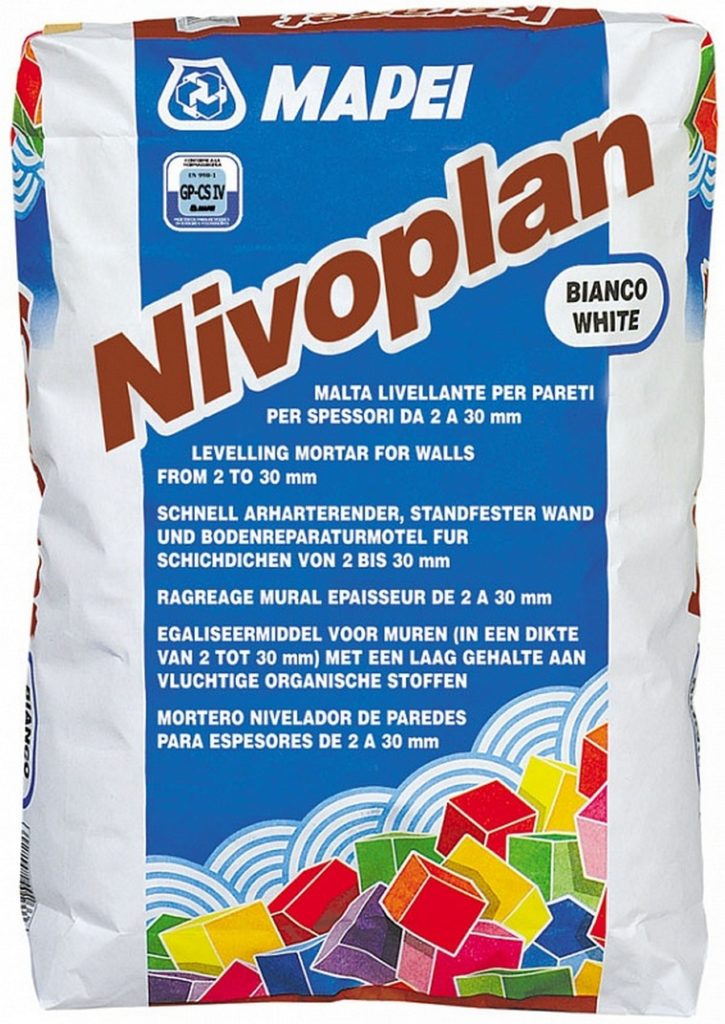
| Name | Index |
|---|---|
| Packing, kg | 25 |
| Manufacturer | Italy |
| Price, rubles | 440 |
- Multifunctional;
- Elastic;
- Good for tiling.
- It has weak contact with gypsum substrates.
1st place: Caparol Streichputz
votes 0
This plaster is designed to create weather-resistant and thin-layer coatings of high quality. The synthetic resins included in the composition make it possible to obtain a solution of the desired consistency, literally adding water “by eye”. It is possible to apply mosaics or applications on the treated surface. There is practically no cracking.

| Name | Index |
|---|---|
| Packing, kg | 16 |
| Manufacturer | Germany |
| Price, rubles | 3330 |
- Ecological cleanliness;
- Strength;
- Large scope.
- Small packing volume;
- Inflated price tag.
Mineral (lime)
2nd place: Weber Vetonit TT40
votes 0
A fairly inexpensive and high-quality sample of universal plaster, suitable for both interior and exterior finishing work. Applied exclusively by hand. Due to its plasticity, this composition allows you to sculpt a decorative texture and stucco molding. Can be used even at 0 degrees.
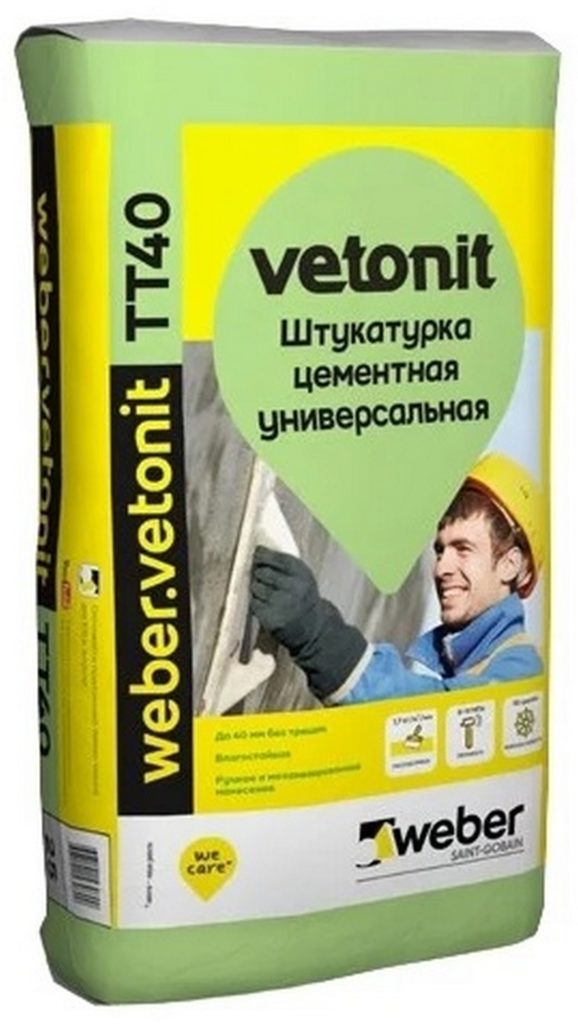
| Name | Index |
|---|---|
| Packing, kg | 25 |
| Manufacturer | Finland |
| Price, rubles | 420 |
- Reduced temperature requirements;
- Possibility of adjusting the consistency;
- Economic spending.
- Not identified (for its segment).
1st place: Ceresit CT 24 Light
votes 0
A very light lime-cement mixture is characterized by excellent moisture resistance. Its main advantage is a very low consumption, which is 20-25% lower than that of analogues. With its help, you can finish uneven walls made of silicate bricks or restore porous concrete. Has excellent adhesion.
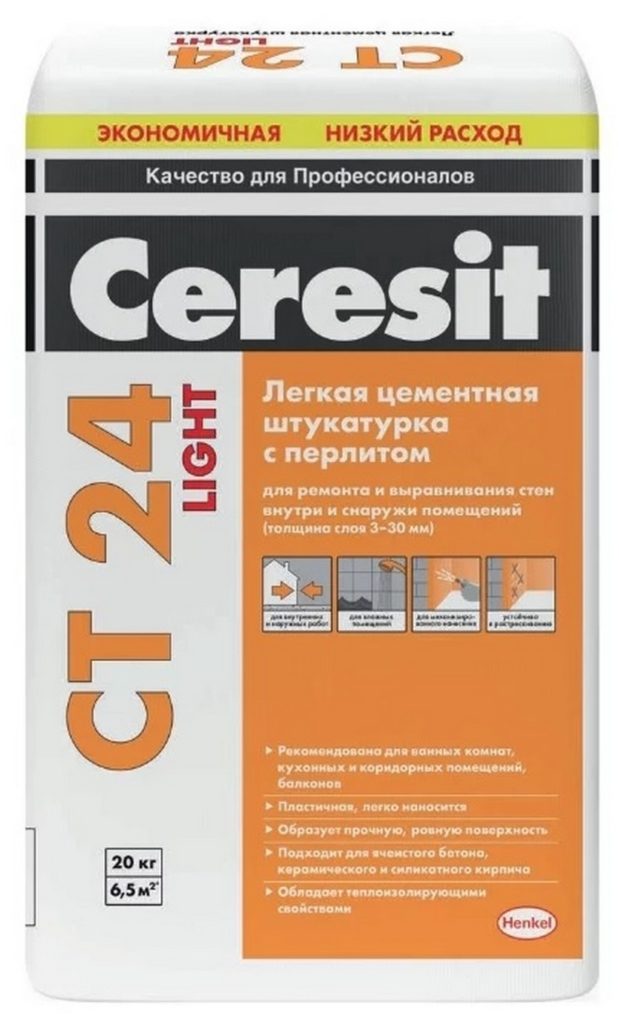
| Name | Index |
|---|---|
| Packing, kg | 20 |
| Manufacturer | Scandinavia |
| Price, rubles | 360 |
- Increased moisture resistance;
- Possesses multifunctionality;
- Great for correcting imperfections.
- Only manual application.
Acrylic
2nd place: Perel Acrilico "Bark beetle"
votes 0
This mixture is the cheapest you can find on the market. Despite this, it provides a durable textured acrylic layer. Works well with concrete and gypsum substrates. It has excellent performance in terms of frost resistance.
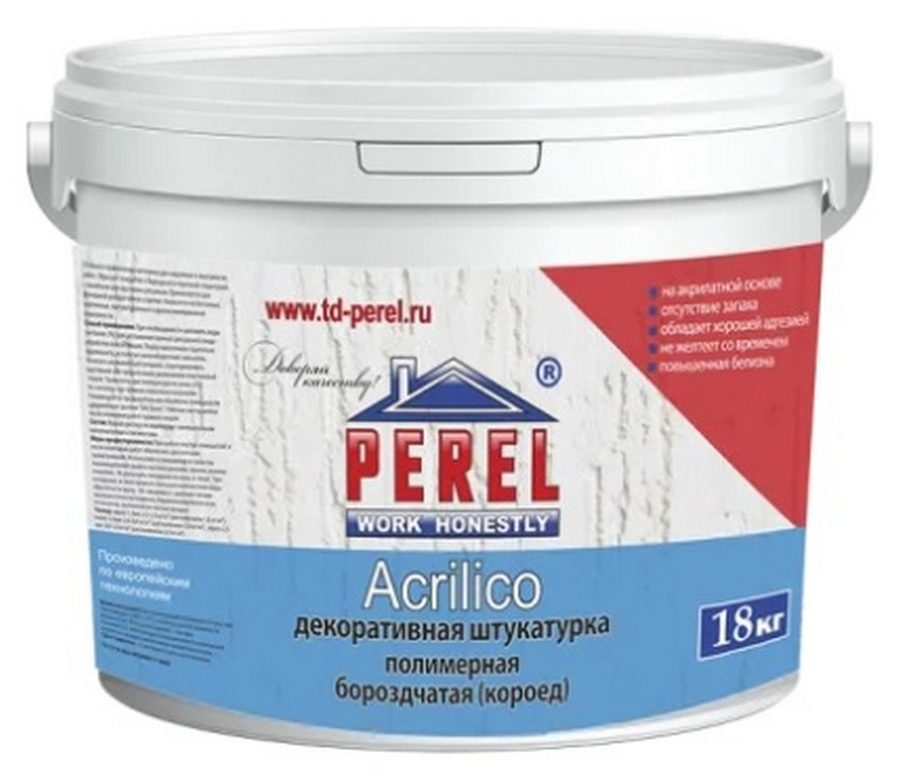
| Name | Index |
|---|---|
| Packing, kg | 18 |
| Manufacturer | Russia (under license from Italy) |
| Price, rubles | 1300 |
- Cheapness;
- Cold resistance.
- Not detected.
1st place: TICIANA DELUXE Alexandria
votes 0
Extremely expensive acrylic-based plaster, can be used both outside and inside. Tinted. Resistant to any impact - from weather to mechanical. Easy to clean without the use of special cleaning products, thanks to the special composition.
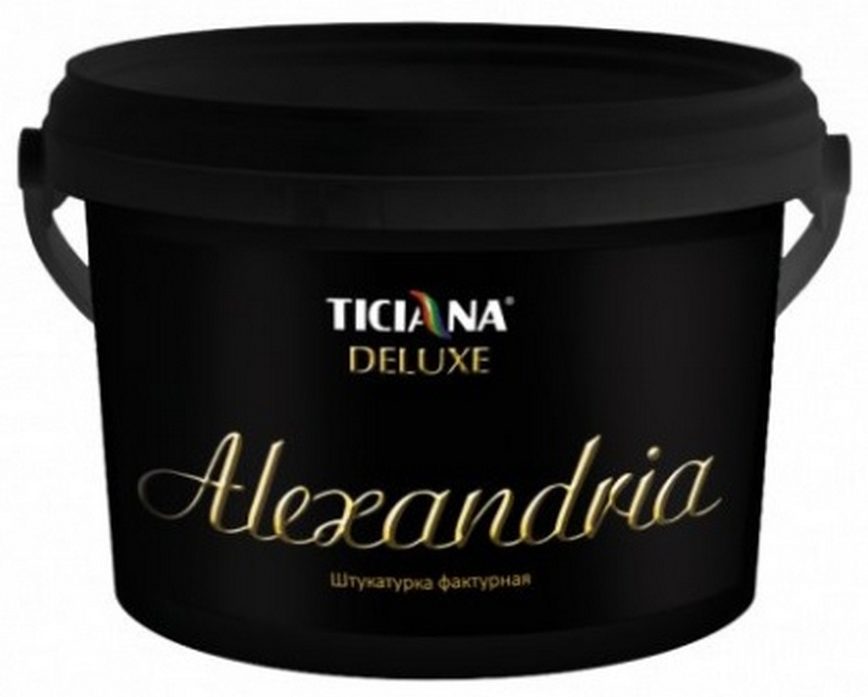
| Name | Index |
|---|---|
| Packing, kg | 13 |
| Manufacturer | Italy |
| Price, rubles | 6300 |
- Easy to clean;
- Universal;
- There is a possibility of tinting.
- Very high price.
Polymeric (silicone and silicate)
2nd place: UNIS LR White Pearl
votes 0
This mixture is supplied immediately ready-made. Amenable to tinting, which can be done by adding special pigments. Great for bringing various exclusive design ideas to life. It has an economical consumption - about a kilogram per square meter with a layer thickness of 1 mm.
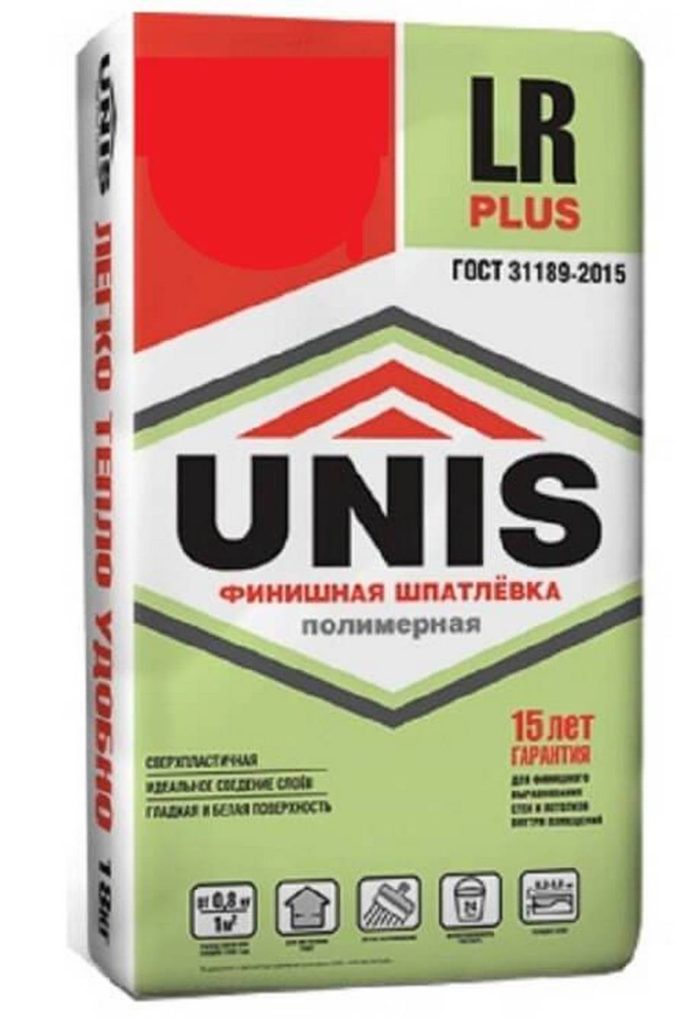
| Name | Index |
|---|---|
| Packing, kg | 25 |
| Manufacturer | Russia (under license) |
| Price, rubles | 600 |
- Is a design material;
- Has the possibility of tinting;
- Can be used for finishing.
- Not suitable for exterior decoration;
- Afraid of low temperatures.
1st place: Bergauf Bau Interior
votes 0
One of the most expensive plasters in the entire world market. Can be applied to any surface except metal and wood. It has a maximum level of adhesion to the surface and dries literally "on the fly". The composition is declared by the manufacturer as absolutely environmentally friendly - it contains no formaldehydes.
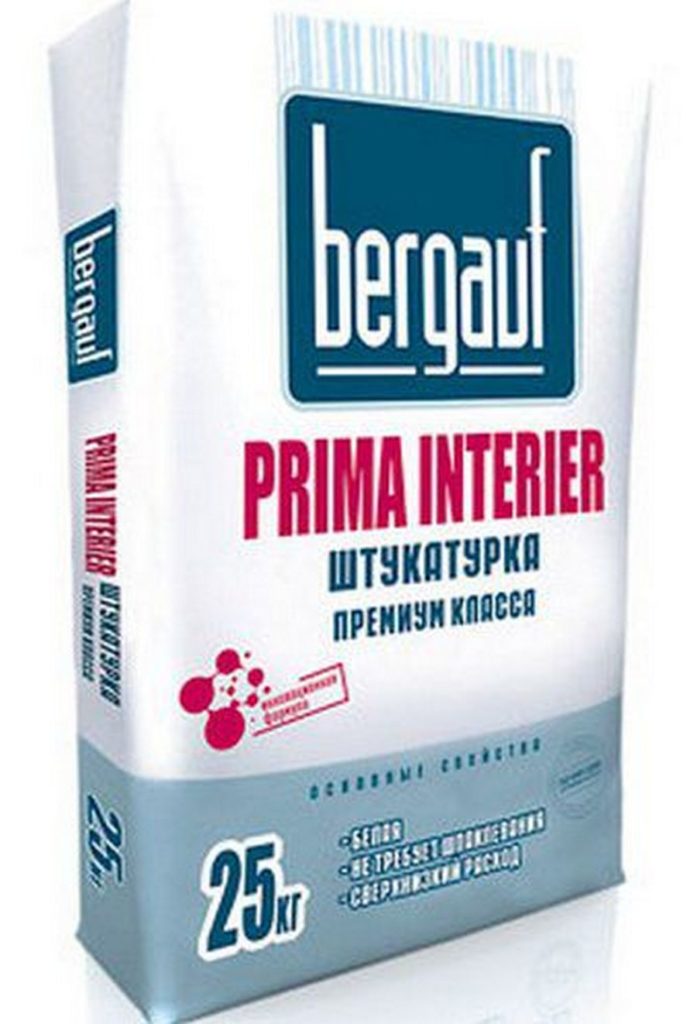
| Name | Index |
|---|---|
| Packing, kg | 25 |
| Manufacturer | Russia (under license) |
| Price, rubles | 340 |
- 100% environmental friendliness;
- Improved adhesion;
- Work with almost any surface.
- Not installed.
Instead of an epilogue
Professionals advise to purchase plaster exclusively in specialized retail chains. Delivery of special solutions from abroad is unlikely to be economically feasible. At the same time, professional skills are required to work with certain solutions.
new entries
Categories
Useful
Popular Articles
-

Top ranking of the best and cheapest scooters up to 50cc in 2025
Views: 131649 -

Rating of the best soundproofing materials for an apartment in 2025
Views: 127688 -

Rating of cheap analogues of expensive medicines for flu and colds for 2025
Views: 124516 -

The best men's sneakers in 2025
Views: 124030 -

The Best Complex Vitamins in 2025
Views: 121937 -

Top ranking of the best smartwatches 2025 - price-quality ratio
Views: 114978 -

The best paint for gray hair - top rating 2025
Views: 113393 -

Ranking of the best wood paints for interior work in 2025
Views: 110317 -

Rating of the best spinning reels in 2025
Views: 105326 -

Ranking of the best sex dolls for men for 2025
Views: 104363 -

Ranking of the best action cameras from China in 2025
Views: 102214 -

The most effective calcium preparations for adults and children in 2025
Views: 102010

